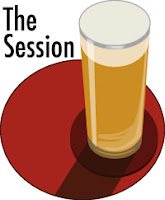 I'm taking a punt, and a liberty, with this month's Session topic. Boak & Bailey are hosting and have asked about "the best beer you can drink at home right now". Though an inveterate ticker, I do have a canon of house beers; the ones I buy on a near weekly basis and often have in stock for inattentive drinking. Kinnegar's Black Bucket is one, Schlenkerla Märzen another, Little Fawn, Duvel, Leann Folláin and Nocturne: desert island beers all, in regular production and a lot less pricey than the one-offs I tend to drink more of, on account of this terrible masochistic hobby I developed twenty years ago.
I'm taking a punt, and a liberty, with this month's Session topic. Boak & Bailey are hosting and have asked about "the best beer you can drink at home right now". Though an inveterate ticker, I do have a canon of house beers; the ones I buy on a near weekly basis and often have in stock for inattentive drinking. Kinnegar's Black Bucket is one, Schlenkerla Märzen another, Little Fawn, Duvel, Leann Folláin and Nocturne: desert island beers all, in regular production and a lot less pricey than the one-offs I tend to drink more of, on account of this terrible masochistic hobby I developed twenty years ago. And because of that, I'm taking a gamble and not writing about any of the above-mentioned. In the golden age of beer blogging, from the UK at least, the beer that got mentioned most for its quality and accessibility was Thornbridge's Jaipur IPA. I'm very fond of a pint myself, when it shows up in my local Wetherspoons. There have been various brand extensions over the years, and last week an unfamiliar one arrived in my eyeline in Redmond's off licence in Ranelagh: Jaipur Noir. I like Jaipur, but I love a black IPA. By rights, and before opening the can, this should be the best beer I can drink at home.
And because of that, I'm taking a gamble and not writing about any of the above-mentioned. In the golden age of beer blogging, from the UK at least, the beer that got mentioned most for its quality and accessibility was Thornbridge's Jaipur IPA. I'm very fond of a pint myself, when it shows up in my local Wetherspoons. There have been various brand extensions over the years, and last week an unfamiliar one arrived in my eyeline in Redmond's off licence in Ranelagh: Jaipur Noir. I like Jaipur, but I love a black IPA. By rights, and before opening the can, this should be the best beer I can drink at home.On the can they assure us that this isn't just Jaipur dyed black, even though it's the same 5.9% ABV. An "array of dark malts" has been employed. An array, no less. It's pretty black in the glass, revealed as a clear deep ruby when held to the light. The aroma is all bright and fresh citrus, with nothing dark hinted at here. It's lightly carbonated, so only a little fizzier than cask Jaipur, and the first impression is the same grapefruit and lemon sherbet you get in the original. After this, there's a faint stout-like dryness, including a most unAmerican bitterness, being green and vegetal, but pleasant. That finishes on a similarly subtle toasty roast. The whole thing is quite subtle, in fact: classy and understated. I enjoyed it, but the beatings of Black Bucket? Not to my taste. It still meets the requirement of the topic, however, because every ticker knows that the best beer you can drink at home is one you've never had before.
 So while I was perusing the Thornbridge section, I picked up a couple of other new ticks. In the middle is Simka, badged as a "plum sour", brewed with an allegedly renowned Japanese variety of plum which, presumably, the name references. It's not made clear. Neither is the beer: it's a hazy pinkish orange in the glass and doesn't smell at all fruity, exuding instead a dry cereal crunch. There's a little more sharpness in the taste -- properly sour, not one of those syrupy fruit concoctions. From the can text, it seems the brewery expects us to be able to taste dark fruit but I certainly couldn't, only a vague berry tartness, blending in with the souring culture. This is another subtle one, hitting the sour points well, and doing it lightly at only 4.2% ABV, but other than the colour, the plums are AWOL. Nobody likes an AWOL plum, and especially when it's a fancy Japanese variety.
So while I was perusing the Thornbridge section, I picked up a couple of other new ticks. In the middle is Simka, badged as a "plum sour", brewed with an allegedly renowned Japanese variety of plum which, presumably, the name references. It's not made clear. Neither is the beer: it's a hazy pinkish orange in the glass and doesn't smell at all fruity, exuding instead a dry cereal crunch. There's a little more sharpness in the taste -- properly sour, not one of those syrupy fruit concoctions. From the can text, it seems the brewery expects us to be able to taste dark fruit but I certainly couldn't, only a vague berry tartness, blending in with the souring culture. This is another subtle one, hitting the sour points well, and doing it lightly at only 4.2% ABV, but other than the colour, the plums are AWOL. Nobody likes an AWOL plum, and especially when it's a fancy Japanese variety. We finish on Thornbridge 90 Shilling, created using the Burton union gadget that the brewery rescued last year from the dastardly grip of Carlsberg-Marston. How is proper 90/- supposed to taste? I have no idea. But what difference can we expect the union to make? Also, no idea. It's 6.3% ABV and badged as an amber ale, with Odell Brewing coming over from Colorado to have a gawk at the kit in action. It is indeed amber, and smells like a crisp and dry bitter: tannic with a little resin. On tasting, that resin blossoms into a full-on incense and black pepper spicing; dry, but balanced by a toffee element, which I guess is where the Scottish cosplay kicks in. Despite these strong and wildly contrasting flavours, it's all integrated, cohesive and balanced. This one isn't subtle: it's bold, and all the more delicious for it. The mineral spicing has me wondering if they've given it some extra Burtonisation, to make the union feel at home. Other than that spurious reasoning, I'm still none the wiser as to what the thing does to a finished beer. Regardless, this is a beaut.
We finish on Thornbridge 90 Shilling, created using the Burton union gadget that the brewery rescued last year from the dastardly grip of Carlsberg-Marston. How is proper 90/- supposed to taste? I have no idea. But what difference can we expect the union to make? Also, no idea. It's 6.3% ABV and badged as an amber ale, with Odell Brewing coming over from Colorado to have a gawk at the kit in action. It is indeed amber, and smells like a crisp and dry bitter: tannic with a little resin. On tasting, that resin blossoms into a full-on incense and black pepper spicing; dry, but balanced by a toffee element, which I guess is where the Scottish cosplay kicks in. Despite these strong and wildly contrasting flavours, it's all integrated, cohesive and balanced. This one isn't subtle: it's bold, and all the more delicious for it. The mineral spicing has me wondering if they've given it some extra Burtonisation, to make the union feel at home. Other than that spurious reasoning, I'm still none the wiser as to what the thing does to a finished beer. Regardless, this is a beaut.Is it too late to change my best-beer-I-can-drink-at-home? I think I have a new candidate.


































